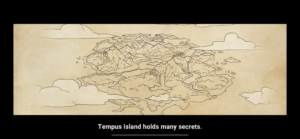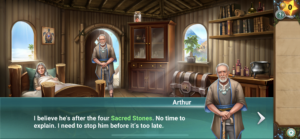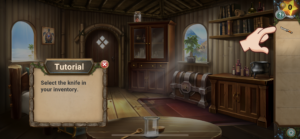For this week’s assignment, I played a game on “Adventure Escape Mysteries.” This app has a number of mystery games, and is published by Haiku Games. It is available on Android, Microsoft, Windows and MacOS. On the app, I played the game called “Legend of the Sacred Stones.” This game has an embedded narrative that players work to uncover by solving mini puzzles and mysteries. I played Chapter 1 of 8 of this game. The types of fun this game evokes are narrative, discovery and challenge.
You enter this game and there is a lot of dialogue, your mother is sick and your father is on a quest to the Temple to fix the curse that is causing the illness. Your task is to help the mother stay healthy (by concocting potions) and also solve mini mysteries to advance towards the goal of uncovering the legend of the stones that will help you undo the curse. This embedded narrative evokes the narrative type of fun.
You tap around and in this process you can discover new objects that will help you accomplish mini tasks. This forms a loop – you tap an object, it reveals something, you tap another object, you learn something else new, and so on until you have the objects you need to accomplish the task at hand. Doing the task is an arc that satisfies a player with the knowledge that they discovered something new, therefore this evokes the discovery type of fun.
One critique I have with this game is that it was pretty difficult to do some of the tasks. The game was challenging so it evoked the challenge type of fun. You had to apply your critical thinking skills to understand which found object accomplished which function. But sometimes, the mini-puzzles were frustratingly difficult and the gain from solving them was minimal, which led to a less than satisfying user experience. Thus, the game needed more first-order optimal strategies. One such FOO strategy was clicking on the characters, because they would often give useful clues or encouragement. They did so in spontaneous and unpredictable ways, though. More clues through characters would quicken the pace of the game, especially as the narrative stalls until players solve the current puzzle. Another way to be quicken the pace would be to introduce easier but timed challenges. This would lead to a more thrilling experience.







